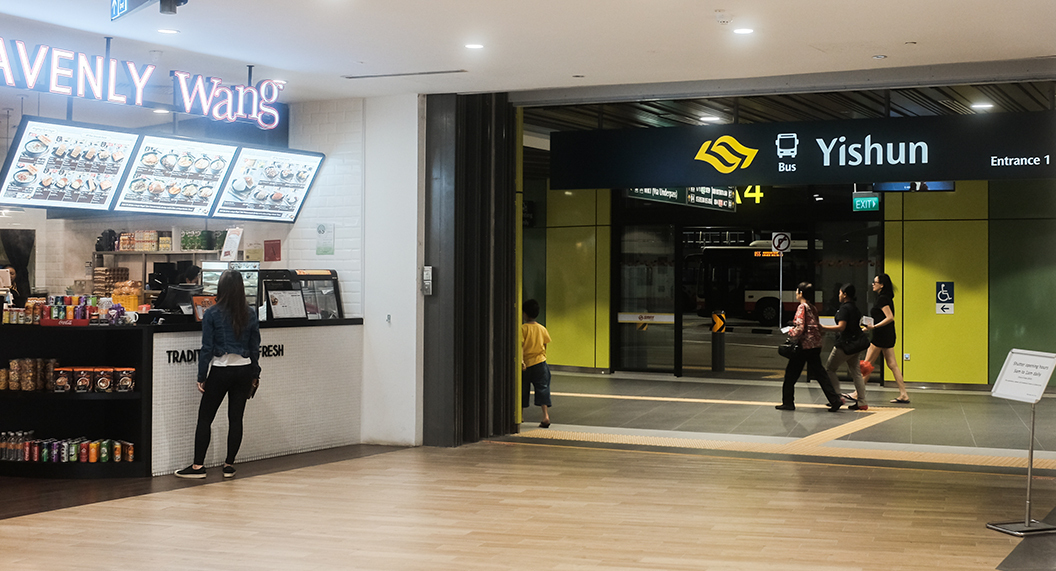Playback speed:
This article lists some examples of neighbourhoods in Singapore, where adjustments have been made to address the needs of persons impacted by dementia. These examples feature the adaptation of different aspects of the environment, including the physical and social environments, to aid wayfinding and support the wellbeing of persons living with dementia.
In addition, this guide by the Lee Kuan Yew Centre for Innovative Cities from the Singapore University of Technology and Design provides guidelines and recommendations for community partners to build Dementia-Friendly Communities (DFCs) across Singapore.
Kebun Baru
To create an inclusive Dementia-Friendly Community (iDFC) in Kebun Baru (KB), a group of students from NUS Chua Thian Poh Community Leadership Centre partners with Dementia Singapore (formerly known as Alzheimer’s Disease Association) to conduct a ground-sensing study to:
• Understand KB residents’ knowledge of and attitudes toward dementia;
• Uncover what a DFC means to them; and
• Explore what can be done to make KB dementia friendly.
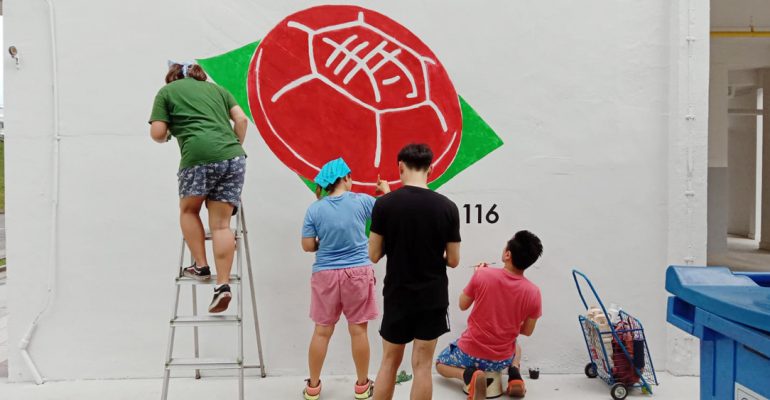
From late 2019 to March 2020, a collaborative project between Dementia Singapore, grassroots leaders, and community partners was conducted in the community of Kebun Baru, Ang Mo Kio. One of the initiatives in this project was the Wayfinding Project, which aimed to make wayfinding, that is, navigation of physical surroundings, easier for persons living with dementia in this community.
Discussions were held with two persons living with young-onset dementia, participants from Dementia Singapore’s Voices for Hope programme for persons living with dementia and their caregivers, and Mr Henry Kwek (Member of Parliament and Advisor for Kebun Baru Constituency). Following this, murals of familiar retro items were painted on strategically-located walls at void decks of HDB blocks in two Residents’ Committees. In effect, these murals can function as landmarks that differentiate buildings and corridors from each other, making it easier for person living with dementia to orientate themselves while moving through this vicinity.
Sources on Kebun Baru: Dementia Singapore1
Woodlands
As part of the Dementia Friendly Singapore initiative spearheaded by the Ministry of Health and supported by the Agency for Integrated Care (AIC) and community partners, a DFC initiative was launched in Woodlands Estate in November 2019.
A key feature of Woodland’s DFC initiative is the Dementia Friends Mobilisation Team. The team is involved in engaging and educating various segments of the community, including young persons, residents, merchants, students, and hawkers, on what dementia is, how to befriend and engage persons living with dementia, and what to do if they encounter a person living with dementia.
Another feature of the DFC initiative is the creation of 15 Go-To Points in Woodlands, which are locations where lost person living with dementia can be brought to. At Go-To Points, trained staff can provide advice, calm persons living with dementia, and aid in identifying and contacting these persons’ next-of-kin. In addition, the public can access information about dementia and these locations. Some of these points currently include shops, medical and social care centres, and a community centre.
Sources on Woodlands DFC: The Straits Times2 and TODAYonline3
Yishun
Yishun, like Woodlands, is also a neighbourhood in Singapore designated as a DFC. The government, private merchants, community organisations, and health and social care partners are involved in making the Yishun community more inclusive for persons living with dementia.
Like other DFCs, Yishun has dementia Go-To Points. One such point at the Sree Narayana Mission Nursing Home is a 24/7 Go-To Point, ensuring that there is round-the-clock support for persons living with dementia in Yishun.4
Notably, the now nationwide Forget Us Not collaborative campaign involving Lien Foundation, Khoo Teck Puat Hospital (KTPH) and Dementia Singapore, which first started as a ground-up initiative in 2016 at KTPH, has conducted education and training sessions for personnel both islandwide and in the Yishun vicinity, where KTPH is located. Amongst other initiatives that the campaign has seen, staff at KTPH’s call centre and Yishun Community Hospital, including more frequently front-facing staff such as security personnel and those stationed at public-facing areas of the hospitals, have undergone dementia training.5,6
The neighbourhood also features blocks repainted with distinctive colours and block numbers to help persons living with dementia differentiate between them, enhancing the ease with which they navigate the area. Murals of fishes, trees and pineapples reminiscent of Yishun’s history were also created to build a sense of the area’s identity amongst residents.
Yishun Integrated Transport Hub, which opened in 2019, is an example of how infrastructure can be designed with an eye on including persons living with dementia. It features a more elder- and dementia-inclusive physical environment, with larger and more easy-to-read directional signs, barrier-free bus boarding and alighting points, and a quiet room for commuters to access a quiet and calming environment.7
Another group on board with efforts to care for persons living with dementia is the Yishun North Neighbourhood Police Centre’s Citizens-on-Patrol team. Members of the citizen volunteer team are trained to detect, respond, and assist persons living with dementia while on patrol.8
Yio Chu Kang
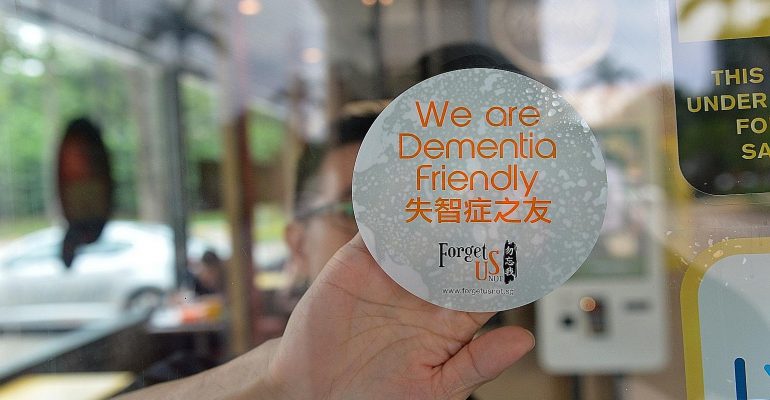
Yio Chu Kang is the third DFC to include dementia-friendly murals on its HDB block walls. Along Ang Mo Kio Avenue 4, at least seven blocks have been painted with the murals, which feature familiar figures like that of the Merlion and sports stars like LeBron James.9
During town audits, AIC collaborated with the AMK Town Council and Grassroots leaders to make plans for upgrading infrastructure to make it more dementia-friendly, such as covering drains to make more footpaths. In the Lentor estate, more prominent estate markers, and intergenerational spaces such as pavilions and playgrounds, fitness areas and community gardens were incorporated into the community map along with directions to the nearest Go-To point from these markers. These help make spaces and buildings more identifiable and accessible to persons living with dementia.
In 2023, several dementia-friendly enhancements were implemented in select areas of Yio Chu Kang to better support those living with dementia. This initiative stemmed from a community-based research endeavor, The Dementia-Friendly Neighbourhood Study, conducted by AIC, the Centre for Liveable Cities (CLC), and the Singapore University of Technology and Design (SUTD). The study, which engaged over 100 residents of Yio Chu Kang and caregivers of persons living with dementia, sought to better understand their unique needs within the community.
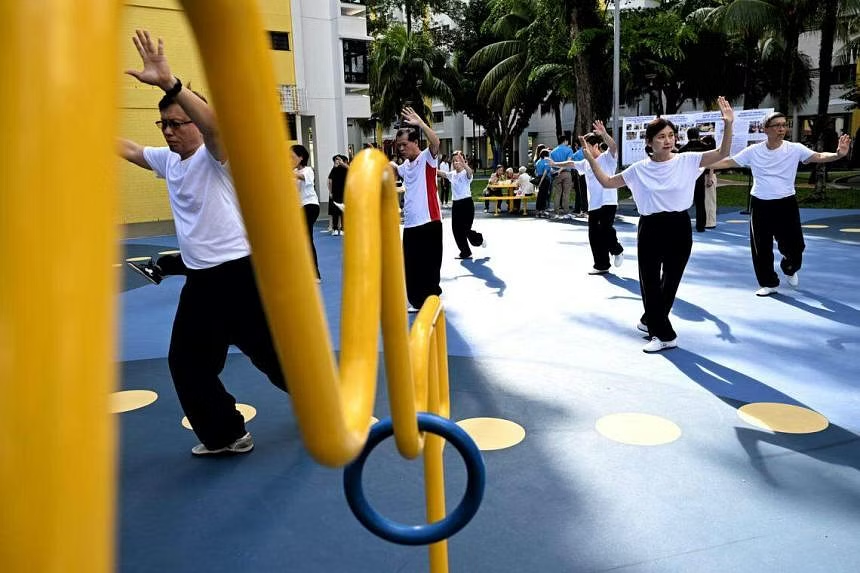
Source: The Straits Times
One notable outcome of this initiative is the establishment of the Blue Court, a dedicated community space designed to foster a sense of belonging and a communal atmosphere.
Within the Blue Court, specialised activity corners were created to offer engaging cognitive exercises and games tailored to persons living with dementia, promoting mental stimulation and improving coordination.
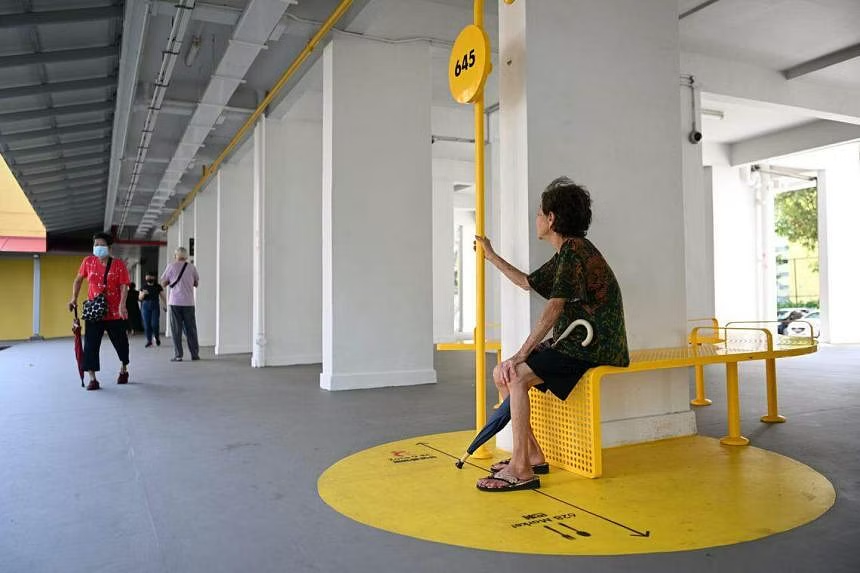
Source: The Straits Times
To facilitate easy navigation for persons living with dementia, bright yellow circle markers resembling buoys were strategically placed throughout the neighborhood. These markers not only serve as visual cues but also provide clear directions to key locations such as the local market.
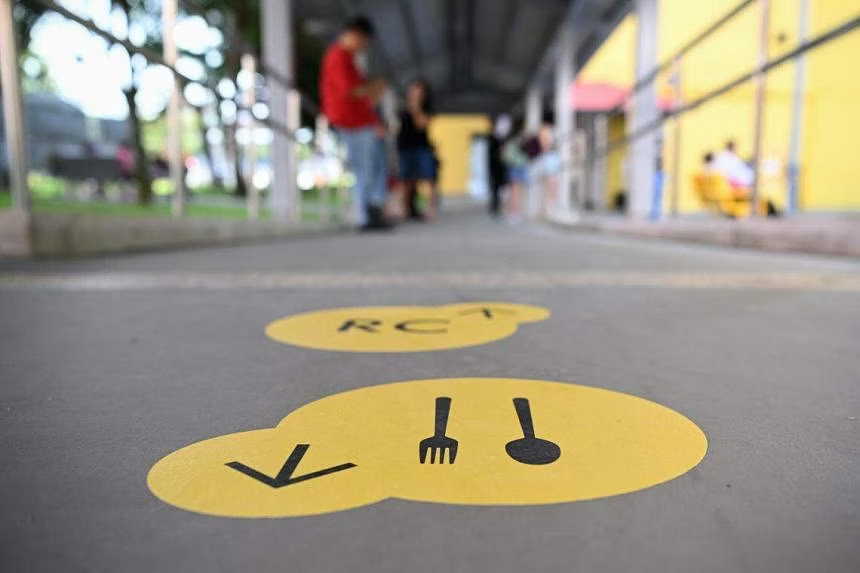
Source: The Straits Times
Utilising simple and universally recognisable symbols, such as utensil icons, these markers guide residents to essential amenities like the nearby hawker center, ensuring seamless navigation and accessibility within the community.
Toa Payoh East
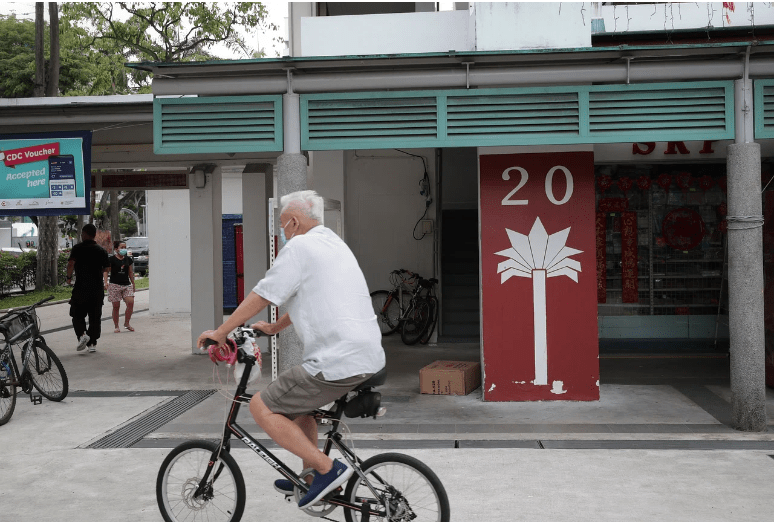
In Toa Payoh East, wayfinding markers with block numbers such as blue sunflowers and red palm trees are painted on the pillars of some HDB blocks to help residents living with dementia find their way around the area. These block markers were designed in consultation with Dr Chan Kin Ming, a geriatrician at Gleneagles Medical Centre. Vivid and contrasting primary colours and larger patterns make it easier for residents living with dementia to tell them apart from the environment.10
In collaboration with various social service agencies, dementia screenings are held once every two months free of charge for seniors to detect dementia early. These initiatives were launched by the Toa Payoh East Citizen Consultative Committee on Feb 12 2022.
The MANGO Programme, which stands for “Meals, Assistance, Needs, Groceries and Opportunities” helps low-income residents with their daily needs. This programme has also been extended to aid those living with dementia. In addition to government subsidies, the programme provides financial assistance and necessities like diapers and wheelchairs.
Toa Payoh West-Thomson
Around 25 banners were put up around the Toa Payoh West-Thomson area to provide access to information and support for caregivers of persons living with dementia. There were also over 120 decals pasted on hawker centre tables around the area to inform residents of how they can support those living with dementia in the neighbourhood. Fortnightly workshops are also held for residents and volunteers to equip them with the skill to identify and assist persons living with dementia. HDB blocks are colour-coded and painted with vibrant colours to help persons living with dementia navigate around the neighbourhood.
Bedok
GoodLife! is a centre run by Montfort Care based in Bedok which actively engages the community to be proactive in understanding the needs of persons living with dementia. The Community Outreach Team (CREST) and befriending team based at GoodLife! Bedok find ways to help busy caregivers find respite amidst their packed schedules. They recruit and train volunteers to act as elder-sitters, caring for persons living with dementia and engaging them meaningfully whilst the caregivers are attending the support group sessions.11
Caregivers can hence find the time for self-care, assured that their loved ones are in competent hands. One of the volunteers expressed how the training was valuable to her: “It is an eye-opener for me and through the lessons, I learnt more about how to better communicate with persons living with dementia and I look forward to the monthly engagement as it makes them happy.”
Marine Parade
Marine Parade was declared a dementia-friendly neighbourhood by Dr Tan See Leng (Minister for Manpower, Adviser to Marine Parade GRC) at during the Marine Parade Dementia Awareness Carnival held on 3 September 2023.
A key feature of Marine Parade is their wayfinding murals which can be found in Blocks 51 to 55 Marine Terrace Drive. During the designing process, Peranakan icons were selected for the wayfinding murals as seniors at Goodlife! Marine Parade were able to recognise these items quickly compared to other icons. Many stakeholders were involved in the discussions on placement and designs such as Dementia Singapore, Montfort Care, Marine Terrace Haven RC, Marine Parade Town Council and WeCare@MarineParade. The painting of the murals was a joint effort between stakeholders, community volunteers, students from CHIJ Katong Convent, and teachers from Tao Nan School.
The Caregiver Support Network was initiated by WeCare@MarineParade in 2019 and officially launched in January 2022. To date, it is more than 100 members strong and regularly holds caregiver workshops and support groups. In addition, it provides a hotline service for the area and a Caregiver Relief Fund that co-pays for medical necessities, home respite services and transport for caregivers requiring financial support.
To promote awareness on dementia and raise awareness on challenges faced by persons living with dementia, decals were pasted at various hawker centres and coffeeshops in Marine Parade between November 2022 and February 2023. In addition, there are also 12 Go-To Points located in the Marine Parade area.
Additional Resources
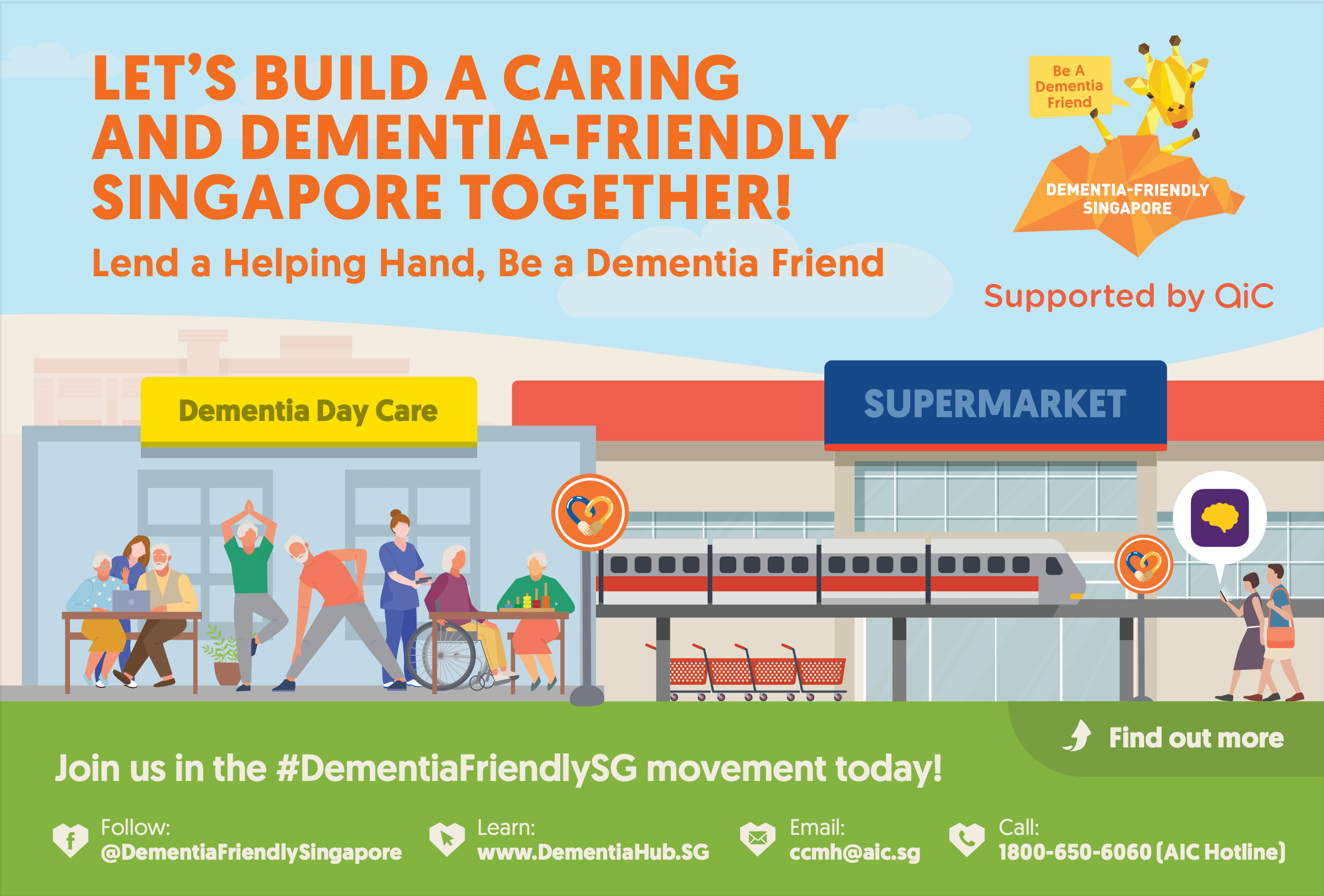
Building Dementia-Friendly Communities
Source: Agency for Integrated Care
This resources provides information, tips and resources on building a dementia-friendly community in Singapore.
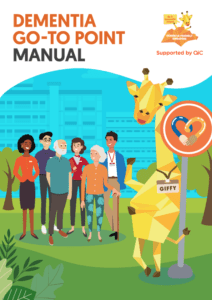
Dementia Go-To Point Manual
Source: Agency for Integrated Care
This manual serves as a reference for employees of organisations in manning the dementia Go-To Points (GTP) to support persons living with dementia in the community. It dovetails the GTP set-up process, role and expectations as well as provides a list of resources in assisting wandering persons living with dementia.
Tell us how we can improve?
- Dementia Singapore. (2020, April 20). Building an inclusive, dementia-friendly Kebun Baru. https://dementia.org.sg/2020/04/20/building-an-inclusive-dementia-friendly-kebun-baru/
- Koh, F. (2019, November 24). Young people to play central role in making Woodlands dementia-friendly. The Straits Times. https://www.straitstimes.com/singapore/young-people-to-play-central-role-in-making-woodlands-dementia-friendly
- Tang, L. (2019, November 24). ‘Not an old-person problem’: Outreach team getting youth to help tackle dementia. TODAYonline. https://www.todayonline.com/singapore/not-old-person-problem-mobilisation-team-involving-youth-tackling-dementia
- Hong, J. (2017, September 10). First 24-hour dementia go-to point launched in Yishun. The Straits Times. https://www.straitstimes.com/singapore/first-24-hour-dementia-go-to-point-launched-in-yishun
- Lien Foundation. (2016, January 20). Yishun, Singapore’s first dementia-friendly estate follows the trend of leading dementia-friendly communities around the world. [Press release]. http://www.lienfoundation.org/sites/default/files/Forget%20Us%20Not%20Press%20Release%20Final%20Combined_0.pdf
- Lien Foundation. (n.d.). Forget Us Not. Retrieved February 22, 2021, from https://www.lienfoundation.org/project/forget-us-not
- Agency for Integrated Care. (2019, October 29). 5 Ways Yishun Integrated Transport Hub is Senior and Dementia Friendly. https://www.aic-blog.com/5-ways-yishun-integrated-transport-hub-senior-and-dementia-friendly
- Yap, E. (2016, January 20). Let’s not forget dementia. Ageless Online. https://www.agelessonline.net/lets-not-forget-dementia/
- Goh Y.H., (2021, June 14). Straits Times. Yio Chu Kang is 3rd town to feature dementia-friendly murals.
https://www.straitstimes.com/singapore/community/yio-chu-kang-is-3rd-town-to-feature-dementia-friendly-murals - Wong S. (2022, February 12). Straits Times. More help for dementia patients and their caregivers in Toa Payoh East.
https://www.straitstimes.com/singapore/community/more-help-for-dementia-patients-and-their-caregivers-in-toa-payoh-east - Channel News Asia. (2022, January 30.) Channel News Asia Video. Dementia-friendly towns help residents live independently.
https://www.channelnewsasia.com/watch/dementia-friendly-towns-help-residents-live-independently-safely-video-2469346

